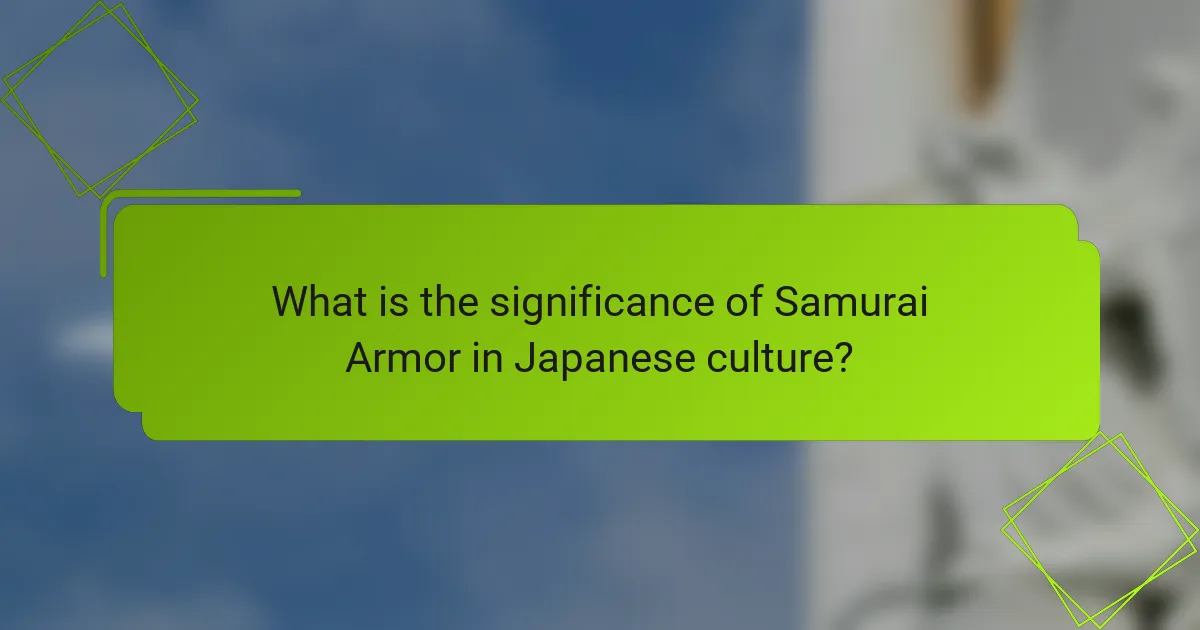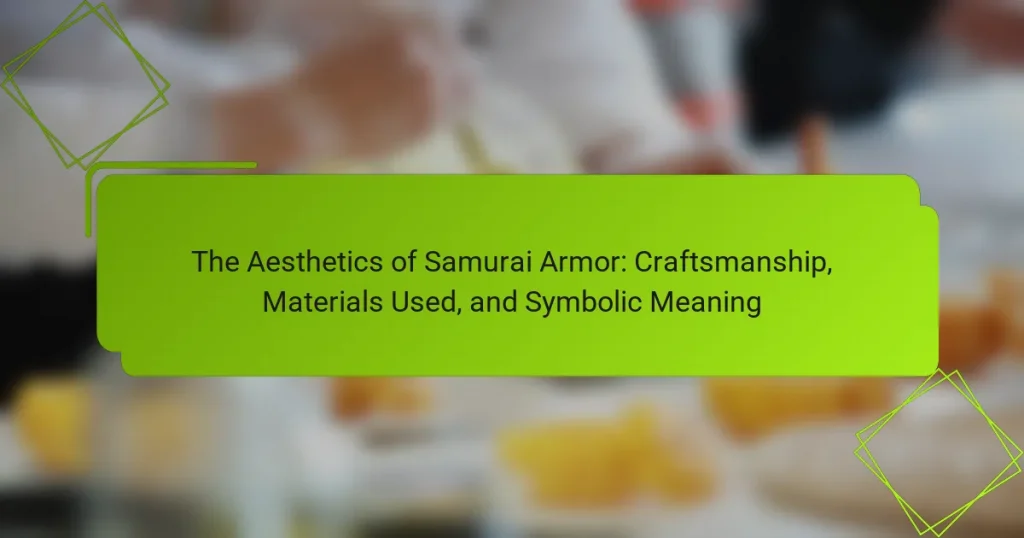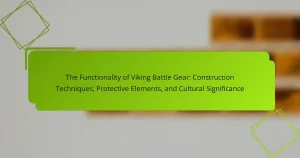Samurai armor is a significant cultural artifact in Japan, representing the warrior class and their ethical code, Bushido. The armor showcases exceptional craftsmanship, utilizing materials like iron and leather that combine functionality with aesthetic appeal. Each piece is uniquely designed, often featuring motifs that signify the wearer’s identity and lineage, embodying values such as bravery and loyalty. The article explores the intricate details of samurai armor, its historical role as both protective gear and a status symbol, and guidelines for collectors regarding authenticity, condition, and provenance to ensure proper care and appreciation of this cultural heritage.

What is the significance of Samurai Armor in Japanese culture?
Samurai armor holds significant cultural importance in Japan. It symbolizes the warrior class and their code of honor. The craftsmanship of the armor reflects the artistry and skill of Japanese artisans. Materials used in armor, such as iron and leather, demonstrate both functionality and aesthetic appeal. Historically, samurai armor was not just protective gear but also a status symbol. Each piece often featured unique designs that conveyed the samurai’s identity and lineage. The armor’s intricate details embody the values of bravery, loyalty, and discipline. Today, samurai armor is celebrated as a cultural heritage, representing Japan’s rich history and traditions.
How did Samurai Armor evolve over time?
Samurai armor evolved significantly from the 8th century to the 17th century. Initially, armor consisted of simple leather and iron components. By the late Heian period, armor featured more intricate designs and layered construction for better protection. The introduction of the kabuto helmet marked a pivotal change, enhancing both defense and aesthetics. During the Muromachi period, armor became lighter and more flexible, allowing for greater mobility in battle. The Edo period saw the rise of elaborate decorations and personalized designs, reflecting the samurai’s status. Techniques such as lacquering and the use of silk became prominent, showcasing craftsmanship. The evolution of samurai armor was influenced by changes in warfare and cultural shifts in Japan.
What historical events influenced the design of Samurai Armor?
The design of Samurai armor was influenced by various historical events, including military conflicts and social changes. The Genpei War (1180-1185) marked a significant shift in armor design due to the need for mobility and protection in battle. The introduction of the Mongol invasions in the late 13th century prompted further innovations to counter new weaponry. The Sengoku period (1467-1603) saw the rise of regional warlords, leading to diverse styles and increased personalization of armor. The Edo period (1603-1868) emphasized aesthetics and ceremonial use, reflecting a shift from warfare to peace. Each of these events shaped the materials, construction techniques, and symbolic elements of Samurai armor.
How did the role of the samurai affect armor aesthetics?
The role of the samurai significantly influenced armor aesthetics. Samurai were elite warriors in feudal Japan, known for their skills and honor. Their status required armor that was not only functional but also visually striking. Armor designs reflected samurai values, such as bravery and loyalty.
Materials used in armor, like lacquered leather and metals, were chosen for durability and beauty. The intricate embellishments on armor, such as family crests and symbolic motifs, showcased personal identity and heritage. The aesthetic appeal of armor was also enhanced by colors and patterns that conveyed rank and affiliation.
Historical records indicate that the aesthetics of samurai armor evolved over time, aligning with changing warfare and cultural influences. Thus, the samurai’s role shaped both the practical and artistic aspects of armor, creating a unique fusion of functionality and beauty.
What are the key components of Samurai Armor?
The key components of Samurai armor include the do, kabuto, sode, kote, and haidate. The do is the main body armor that protects the torso. The kabuto is the helmet, often adorned with crests. Sode are the shoulder guards that provide additional protection. Kote refers to the armored sleeves that shield the arms. Haidate protects the thighs and upper legs. Each component is crafted from materials like iron, leather, and silk. The design of Samurai armor also reflects the samurai’s status and clan affiliation. Historical records show that armor was both functional and symbolic, highlighting the craftsmanship of the era.
What materials are traditionally used in the construction of Samurai Armor?
Samurai armor is traditionally constructed using materials such as iron, leather, and silk. Iron plates form the main protective components. These plates are often lacquered for durability and aesthetics. Leather is used for flexibility and comfort, particularly in straps and fittings. Silk cords are employed to bind the armor pieces together. Additionally, some armor incorporates textile elements for added protection and decoration. Historical accounts indicate that these materials were chosen for their balance of strength and mobility. The combination of these materials reflects the craftsmanship and cultural significance of Samurai armor.
How do different components contribute to the overall functionality of the armor?
Different components of armor contribute to its overall functionality through protection, mobility, and comfort. The main body plates provide essential defense against weapons. They are often made from materials like iron or leather, which absorb and deflect blows. The shoulder guards enhance protection while allowing for arm movement. This design facilitates combat readiness. The helmet protects the head and often includes a faceguard for visibility and defense.
Additional elements like the lacing and straps ensure a secure fit, preventing movement during battle. The weight distribution across the body allows for agility. Each component is crafted to balance protection and mobility, essential for a samurai’s effectiveness in combat. Historical samurai armor was designed to withstand various attacks while enabling swift movement, showcasing the importance of each part’s contribution to overall functionality.
What craftsmanship techniques are employed in making Samurai Armor?
Samurai armor is crafted using several traditional techniques. These techniques include forging, lacquering, and weaving. Forging involves shaping metal plates through heating and hammering. This process creates strong yet flexible armor components. Lacquering provides a protective finish and enhances the armor’s aesthetic appeal. Weaving techniques are used in creating the cords and textiles that hold the armor together.
Additionally, the use of layering is significant in armor construction. Multiple layers of materials offer increased protection and flexibility. Each piece is meticulously crafted to fit the wearer’s body. Historical records indicate that these craftsmanship techniques have been refined over centuries. The combination of these methods contributes to the distinctive look and functionality of Samurai armor.
What are the unique skills required by craftsmen to create Samurai Armor?
Craftsmen require specialized skills to create Samurai Armor. These skills include metallurgy for forging metal components. They must master techniques in leatherworking for creating protective layers. Knowledge of traditional weaving is essential for fabric elements. Attention to detail is crucial for intricate designs and embellishments. They also need expertise in lacing and assembly methods. Understanding historical significance enhances the authenticity of the armor. Finally, craftsmanship demands a deep appreciation for aesthetics and functionality. Each skill contributes to the overall quality and symbolism of the armor.
How does the craftsmanship reflect the aesthetic values of the time?
Craftsmanship in samurai armor reflects the aesthetic values of its time through intricate designs and materials. The use of high-quality metals and textiles showcases the importance of beauty and functionality. Artisans emphasized detailed engravings and lacquer finishes, highlighting the cultural significance of visual appeal. Each piece of armor was tailored to not only protect but also convey status and artistry. Historical records indicate that samurai armor often featured motifs representing virtues like loyalty and bravery. This connection between craftsmanship and aesthetic values illustrates the deep cultural roots in samurai traditions. The craftsmanship also demonstrates a blend of practicality and artistic expression, embodying the ethos of the era.

What symbolic meanings are associated with Samurai Armor?
Samurai armor symbolizes honor, loyalty, and the warrior spirit. It represents the samurai’s commitment to their code of ethics, known as Bushido. The intricate designs and craftsmanship reflect the status and identity of the wearer. Each piece of armor often features specific motifs that convey personal or clan significance. For example, family crests on armor signify lineage and heritage. The use of materials like leather and metal showcases strength and resilience. Additionally, the aesthetic beauty of samurai armor serves as a reminder of the balance between form and function in warfare. Historically, samurai armor was not only protective but also a statement of pride and cultural identity.
How does Samurai Armor represent status and identity?
Samurai armor represents status and identity through its intricate craftsmanship and unique designs. The armor was often customized to reflect the samurai’s rank and family heritage. High-ranking samurai wore elaborate armor adorned with family crests and distinctive colors. These elements signified their noble lineage and social status. Additionally, the materials used in the armor, such as lacquered metal and silk, conveyed wealth and prestige. The style and decoration of the armor also communicated the samurai’s personal identity and values. For instance, specific motifs could symbolize bravery or loyalty. Thus, samurai armor served as a powerful visual representation of both individual and familial identity within the feudal hierarchy of Japan.
What colors and designs are significant in Samurai Armor symbolism?
Significant colors in Samurai armor symbolism include red, black, and gold. Red represents bravery and valor in battle. Black symbolizes strength and authority. Gold signifies prestige and high rank. Designs often feature motifs like family crests and nature, representing lineage and connection to the environment. The use of specific colors and designs conveyed the samurai’s status and values. Historical records show that colors were carefully chosen for their symbolic meanings. For instance, the famous armor of Takeda Shingen prominently featured red, emphasizing his fierce reputation.
How does the armor reflect the samurai’s personal beliefs or clan heritage?
Samurai armor reflects personal beliefs and clan heritage through its design and symbolism. Each piece often carries motifs that signify loyalty, bravery, and honor. Clan emblems, or mon, are prominently displayed, indicating the wearer’s lineage. Specific colors and materials used can also represent the values of the clan. For example, the use of certain metals or fabrics may signify wealth or status. Additionally, the craftsmanship involved often reflects the samurai’s dedication to their principles. Historical records show that armor was customized to embody individual beliefs, making each suit unique. These elements collectively illustrate the deep connection between the armor and the samurai’s identity.
What role does Samurai Armor play in modern representations of samurai culture?
Samurai armor serves as a powerful symbol of samurai culture in modern representations. It embodies the values of honor, bravery, and tradition associated with the samurai class. The intricate craftsmanship of the armor reflects the artistic skills and dedication of artisans. Modern media, such as films and video games, often showcase this armor to evoke a sense of nostalgia and cultural pride. Exhibitions in museums further highlight its historical significance and aesthetic beauty. The armor’s distinctive design elements, such as the kabuto helmet and elaborate patterns, are often used as visual shorthand for samurai identity. Overall, samurai armor remains a vital link to Japan’s feudal history and cultural heritage.
How is Samurai Armor depicted in contemporary media and art?
Samurai armor is depicted in contemporary media and art as a symbol of strength and honor. It often appears in films, video games, and anime, showcasing its intricate design and historical significance. Artists frequently highlight the craftsmanship involved in creating the armor. This includes the use of materials like lacquered metal and silk. The visual representation emphasizes the armor’s aesthetic appeal and cultural heritage. Exhibitions in museums also feature samurai armor, illustrating its role in Japanese history. These portrayals contribute to a broader appreciation of samurai culture in modern society.
What impact does this representation have on cultural perceptions of samurai?
The representation of samurai armor significantly influences cultural perceptions of samurai. It shapes the image of samurai as noble warriors and skilled artisans. The intricate craftsmanship of armor highlights their dedication to martial excellence. This portrayal fosters admiration for their discipline and honor. Additionally, the materials used in armor symbolize status and power. For example, the use of rare metals and elaborate designs conveys wealth and prestige. Consequently, these representations reinforce the romanticized view of samurai in popular culture. Films and literature often depict them as heroic figures, impacting public perception. Overall, such representations create a lasting legacy that shapes how samurai are viewed today.

What are the practical considerations for collectors of Samurai Armor?
Collectors of Samurai Armor should consider authenticity, condition, and provenance. Authenticity ensures the armor is genuine and not a replica. Condition affects the armor’s value and desirability. Collectors should examine for wear, repairs, and restoration. Provenance provides historical context and increases value. Documentation of previous ownership can enhance the armor’s appeal. Storage and display are also crucial. Proper care prevents deterioration and preserves aesthetics. Understanding market trends helps in making informed purchases. Collectors should engage with reputable dealers and attend exhibitions for education and networking.
How can one assess the authenticity of Samurai Armor?
To assess the authenticity of Samurai Armor, examine its construction details and materials. Genuine Samurai Armor often features intricate craftsmanship, including hand-forged metal parts and traditional lacquering techniques. The use of specific materials like iron, leather, and silk is characteristic of authentic pieces. Look for historical markings or signatures from recognized craftsmen, which can indicate authenticity. Additionally, study the armor’s design elements, such as the presence of specific motifs or styles that correspond with the era it represents. Researching provenance and previous ownership can also provide valuable context for authenticity. Authentic Samurai Armor typically shows signs of age and wear consistent with its historical use.
What common characteristics should be examined in authentic pieces?
Authentic pieces of samurai armor should be examined for craftsmanship, materials, and symbolic meaning. Craftsmanship is evident in the intricate designs and techniques used in the armor’s creation. The materials, such as iron, leather, and silk, contribute to both durability and aesthetic appeal. Symbolic meaning is reflected in the motifs and colors, which often represent the wearer’s clan or personal values. Historical records indicate that these characteristics were crucial in distinguishing authentic armor from replicas. For example, the use of specific weaving techniques in silk indicates the period and origin of the armor.
How does provenance affect the value of Samurai Armor?
Provenance significantly affects the value of Samurai Armor. The history of ownership adds to the item’s uniqueness and cultural significance. Armor with a documented lineage commands higher prices at auctions. Provenance can include previous owners, historical battles, or notable samurai associations. Items linked to famous warriors or events are more sought after. Collectors value authenticity, which provenance helps establish. The market for Samurai Armor often prioritizes pieces with clear, traceable histories. This trend reflects a broader appreciation for heritage in collectible artifacts.
What tips should collectors consider when acquiring Samurai Armor?
Collectors should verify the authenticity of Samurai Armor before acquiring it. Authentic pieces often come with provenance documents or expert appraisals. Examine the craftsmanship closely; traditional armor features intricate designs and high-quality materials. Look for signs of aging that indicate historical value, such as patina or wear consistent with age. Research the specific type of armor, as there are various styles, each with unique characteristics. Consider the armor’s condition; restoration can affect value. Consult with experts or reputable dealers who specialize in Japanese artifacts. Understanding the cultural significance enhances appreciation and ensures informed purchasing decisions.
How can collectors ensure they are making informed purchases?
Collectors can ensure they are making informed purchases by conducting thorough research on samurai armor. Understanding the craftsmanship, materials, and historical significance is essential. Collectors should examine reputable sources, such as academic publications and expert analyses. Engaging with knowledgeable dealers and attending specialized auctions can provide valuable insights. Authenticity verification through established provenance is crucial to avoid counterfeit items. Additionally, joining collector communities can facilitate information exchange and support. Collectors should also compare prices and market trends to gauge fair value. This comprehensive approach helps mitigate risks and enhances the overall purchasing experience.
What resources are available for learning more about Samurai Armor?
Books, academic articles, and online resources are available for learning about Samurai Armor. Notable books include “Samurai Armor: The History and Craft of the Samurai Warrior” by John M. K. Hutton. This book details the craftsmanship and materials used in armor creation. Academic articles can be found in journals like “Asian Art” and “The Journal of Japanese Studies.” These articles often explore the cultural significance and symbolic meanings of Samurai Armor. Online platforms such as JSTOR and Google Scholar provide access to a wide range of scholarly resources. Museums with Japanese art collections, like The Metropolitan Museum of Art, offer educational resources and exhibitions on Samurai Armor.
The main entity of this article is Samurai Armor, which represents a significant aspect of Japanese culture, embodying values such as honor, loyalty, and craftsmanship. The article explores the evolution of Samurai Armor from the 8th to the 17th century, detailing the historical events that influenced its design and the unique components that contribute to its functionality. It also highlights the materials traditionally used in armor construction and the craftsmanship techniques employed by artisans. Furthermore, the article examines the symbolic meanings associated with Samurai Armor, including its role in representing status and identity, as well as its contemporary representations in media and art. Lastly, practical considerations for collectors, such as authenticity, provenance, and resources for further learning, are discussed.




